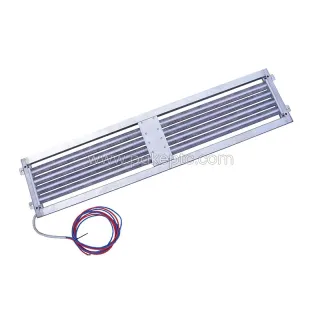What is a positive temperature coefficient?
At the heart of all Xtreme Engine Heaters is the PTC heating element.
How does PTC work?
PTC is an abbreviation for “Positive Temperature Coefficient”.
PTC Technology offers significant benefits in two key areas of importance that make them well suited and safe for use in your boat’s bilge space. First and foremost is safety. PTC heaters are self limiting, which means that as they approach their design operating temperature, electrical consumption is automatically decreased. PTC heaters are incapable of overheating.
The Xtreme Heater PTC element is set for a maximum output level that can adequately provide enough heating power to maintain above-freezing temperatures within the engine compartment at minimum ambient temperatures. The difference between an Xtreme Heater and traditional heaters is that this power level changes automatically in response to ambient or environmental demands.
So, what happens if a thermostat fails in the on position when a ptc heater is in the system? The heater will reduce power to a minimum operating level without overheating anything. Sort of like treading water.
What happens if the fan fails and there is no airflow? Again, the PTC element powers down to a minimum operating level without overheating; it remains operational to prevent freeze damage as a convection heater.
If there is a sudden thermal load placed on the heating system either by falling ambient temperatures or a consumer-caused condition, such as opening the engine compartment hatch allowing cold air to enter, the PTC heater will automatically increase its heating power to replace the heat loss. As soon as this has been accomplished the heater will stabilize again at a lower power level, it will go back to “treading water” mode.
When you use a PTC-based heater and a thermostat you have a control situation that can be compared to a person who wears both a belt and suspenders. It is equally as safe to eliminate the thermostat entirely and let the PTC control the temperature. Traditionally, temperature regulation has been accomplished using a combination of a fixed resistance heating element and a thermostat. This has been, and still is today, a reliable method for heating hot water, space heaters and ovens. However, a problem can arise if the thermostat or fan fails in this type of heater. The element will keep on heating at its maximum rating with no way of shutting it down even as temperatures increase to an unsafe level.
The last thing you want in the bilge of your boat is a “runaway” heating element. The second key benefit afforded by PTC technology is efficiency. The Xtreme PTC heating element draws full rated power upon startup to quickly heat the element, and reduces power consumption as operating temperature is reached. The heater only works as hard as it has to in order to maintain temperature, saving energy and achieving more consistent temperature control of the engine compartment.
Xtreme Heaters provide the heat your engine compartment requires to stay warm, safely and with reduced energy consumption …
Self-regulating PTC Heating Technology for fail-safe heating — Industrial Heating & Cooling - DBK Industrial
Multi-voltage capability
Due to the PTC effect and the resulting variable resistance, semiconductors are multi-voltage capable in a defined range. For example, most PTC heaters can be operated at 230 V as well as at 400 V without any significant change in power.
Dynamic power adaptation
The power output of a PTC heating element depends on the heat extraction. If a lot of heat is extracted from the semiconductor, it automatically readjusts its temperature and increases its power. As soon as it reaches its maximum temperature, the power decreases again and hardly any current flows. This dynamic power adjustment makes PTC heating elements especially energy-efficient.
Self-limiting effect
Due to the logarithmic increase of the PTC's natural resistance in relation to the temperature, the PTC limits itself. As soon as the maximum temperature is reached, the semiconductor becomes non-conductive and settles due to the physical effect. Thanks to this effect, PTCs are particularly safe and do not require any additional thermal fuse.
Automotive - Electric Vehicle PTC Heaters
Electric Vehicle PTC Heaters
Positive temperature coefficient (PTC) heaters bring efficiency and safety to EV heating systems. The heating element inside a PTC heater has a positive temperature coefficient and its resistance increases with temperature. When power is first applied to the cold PTC heating element, it has a low resistance and draws a large amount of current. As it heats up, the resistance increases and the current draw decreases. This makes a PTC heater inherently both safe and efficient; the PTC heater will stop drawing current if it overheats and it only draws the current it needs to maintain temperature. A PTC heater also heats faster than a traditional element, as it draws maximum current when it is cold.
Positive temperature coefficient (PTC) heaters bring efficiency and safety to EV heating systems. The heating element inside a PTC heater has a positive temperature coefficient and its resistance increases with temperature. When power is first applied to the cold PTC heating element, it has a low resistance and draws a large amount of current. As it heats up, the resistance increases and the current draw decreases. This makes a PTC heater inherently both safe and efficient; the PTC heater will stop drawing current if it overheats and it only draws the current it needs to maintain temperature. A PTC heater also heats faster than a traditional element, as it draws maximum current when it is cold.
- 0




